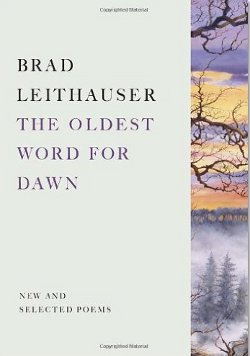The Oldest Word for Dawn: New and Selected Poems
by Brad Leithauser
reviewed by William Doreski
The Oldest Word for Dawn selects from some thirty years of Brad Leithauser’s poetry, adding about fifty pages of new work. In his Author’s Note, Leithauser defines his ideal reader as “someone who shares my love of animals, including weird prosodic animals; who senses poetry in numbers; who sees no reason why even an emotionally complicated human story might not naturally unfold in verse.” Fair enough. However, his poems do contain weird prosodic animals, some untamed, and he risks stirring a resistance in some readers who react not to the poetry in numbers but to the numbers in poetry: their metrical, sonic, and linear demands.
The poems of Leithauser’s first couple of collections reminded some reviewers of Marianne Moore’s intricate syllabic constructions; others thought of Auden’s later work, especially the About the House poems, or Richard Wilbur’s slightly offhand elegance. Sometimes the formal echoes seemed too insistent, and sometimes a perceived disparity between method and content defied the still-current ideal of organic form. In Hundreds of Fireflies (1982) most of the poems are aggressively visual and linguistically alert:
One dandelion
is yellow, is a solar flame
spoking from a green nether rim;
the other gray, a dainty crumb-
cake of a moon. (“Miniature”)
Poems like this lean heavily on description and avoid energetic verbs, relying more on the copula, underscoring the stasis of a caught moment. Such a poem can sustain itself and thrive with a relatively static notion of form. But other of these early poems display the narrative bent that becomes the dominate note in Leithauser’s later work.
Contemporary narrative poems seem to require a more flexible shape and rhythm. They don’t slip easily into the elegance of lyric modalities. “Two Summer Jobs” is an example of “an emotionally complicated human story” that “naturally unfold[s] in verse”:
Mrs. Dow speaks of a friend’s friend’s son
who committed suicide after
his first Harvard exam. A lighter
flares beside me, and cigarette smoke
crowds the air. “Teacher don’t allow
any smoking.” Freshened laughter
greets sad Mrs. Klein’s unlikely quip.
This moves comfortably enough, the syntax and lineage absorbing dialogue in an easy flow of enjambments. But later on, in poems like “The Odd Last Thing She Did,” Leithauser embraces rhyme that, with formal stridency, forces the reader to pause longer on the line endings. This can disturb the narrative flow and sometimes almost suggests doggerel, which we might define as verse that is so emphatically verse it can’t be mistaken for poetry. But is this an appropriate criticism of a poet as skillful and intelligent as Leithauser? Do the heavy end-rhymes substantially negate the subtle unfolding of the story? Actually, “The Odd Last Thing She Did” represents a collision of strengths: lyric intensity and skill, and narrative drive.
A car is idling on the cliff.
Its top is down. Its headlights throw
A faint, bright ghost-shadow glow
On the pale air. On the shore, so far
Below that the waves’ push-and-drag
Is dwindled to a hush—a kind
Of oceanic idle—the sea
Among the boulders plays a blind-
Fold game of hide and seek.
Following this, a sensitive, finely delineated story of a young woman’s suicide unfolds. Yet the straining for rhyme (breaking “blindfold” over two lines to achieve a rhyme with “kind”), the odd pun of “idle,” and the general roughness of rhythm suggest that this story is torn between the exigencies of prose narrative and the ghost of orality lingering in verse. Genuinely oral verse avoids heavy enjambment. The oral poem requires coherent line by line construction to facilitate recall, and complex syntax adds unwanted difficulties. Prose narrative, on the other hand, does not usually allow aural ornament to impede its flow. In modern idiom, aimed at the page rather than the ear, rhymed narratives present problems alien to Homer’s aesthetic. Leithauser handles this form as well as anyone could, but the issue is whether certain elements of modern lyric technique—including heavy enjambment and startling and often static visual imagery—appropriately complement his largely narrative imagination.
The issue looms even larger in his most recent poetry. What happens when Leithauser relinquishes his lyric ambitions and focuses on narration? At their baldest, these recent poems sacrifice intensity for psychological acuity, as in this passage from “Bad Breaks”:
She felt it bitterly: the task of weeping was now hers alone.
. . . Yet there were odd, dislocating interludes when
she observed things from some variant zone—seeing herself outside herself—and then she knew
that this person she’d chosen to live beside,
her husband, was doing everything a soul could do.
At such moments, these poems sound a bit like Frank Bidart’s, but without the complex emotional machinery. However, elsewhere Leithauser retains some lyric intensity and linguistic daring, and the gain in intensity—without loss of narrative momentum—is notable. Poems like “An All But Empty Set,” “The Birth of Injustice,” and “The Horse in the Gallery” unfold with narrative deliberation while maintaining a sharp edge that makes them unmistakably poetry and not versified prose.
Leithauser has moved in various directions along the way, most digressively in the poems of Cats of the Temple, with its double-columned monometer-dimeter poems, ode-shaped poems that don’t read like odes, and other experiments in visual and sonic form. But he has always maintained a strong grasp of the momentum that comes when syntax and line work in harmony, and in his best poems—including some of the recent ones—this pays off handsomely.
Published on February 11, 2014

